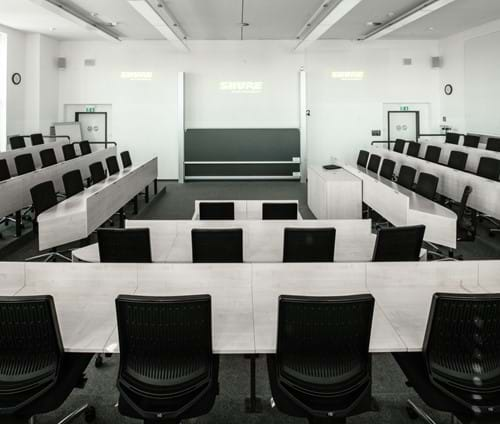How Utilizing CARES Act Funding Helps to Transform Learning for US Colleges and Universities

Don’t forget to consider improving your AV collaboration equipment when utilizing government funding
It’s been a year since the CARES Act was passed by Congress on 27th March 2020. To give it its full name, the Coronavirus Aid, Relief, and Economic Security Act made available $2.2 trillion to provide fast and direct economic relief to those negatively impacted by the COVID-19 pandemic. A proportion of this ($14 billion) was set aside specifically to help higher education facilities continue to deliver learning.
This funding isn’t just about providing students with grants and laptops. It’s also about investing in the technology that helps your institution uphold a high level of student comprehension and engagement during changing times. Now, a second round of funding, the Higher Education Emergency Relief Fund II (HEERF II), offers colleges and universities another opportunity to upgrade or enhance the technology they’re using to maintain academic excellence.
This funding is available right now. It’s set to accelerate the digital journeys of academic institutions across the US, moving beyond the laptops and whiteboards that are increasingly part of modern education facilities, to embrace audio visual (AV) technology as well. That’s because the sudden increase in remote learning last year turned the spotlight on the huge value of AV.
Investing in collaboration capabilities
Like businesses across the corporate world, many higher education institutions used some of the available funding to offer collaboration platforms, such as Zoom and Microsoft Teams, to all students and teachers. In fact, Microsoft CEO Satya Nadella famously said in April 2020: “We’ve seen two years’ worth of digital transformation in two months.” At that time, more than 183,000 educational institutions around the world were using Teams.
However, while connectivity via these platforms has kept education going, experience now shows that something more is needed – audio clarity. For learning to be fully inclusive, high-quality audio for streaming lessons and distance learning allows students to participate in classes and lectures, no matter where they’re located.
Further, many on-campus classrooms have now been set up to accommodate social distancing guidelines. This requires full room audio coverage, regardless of the size and shape of the classroom or lecture hall. In larger classrooms, where fewer students are now spaced apart, some higher education institutions are benefiting from voice lift technology to ensure everyone’s comments are heard.
Crystal clear audio
This intelligibility really does matter. In an academic experiment assessing the impact of audio quality on how scientific researchers’ presentations were perceived, a video recording was purposefully made difficult to hear. Viewers thought this talk was worse than those who experienced it with high-quality audio. The talker who was broadcast with poor audio was perceived as less intelligent and less likeable, and the research less important than the exact same presentation with the audio quality enhanced.
Intelligibility also contributes to how much knowledge students retain (recall). This has been borne out in a wide range of academic research projects into educational acoustics dating back many years. In just one example from Sweden, ‘unfavorable listening conditions’ were cited as a reason for both impaired speech intelligibility and recall.
In another research article, we read as follows: “A significant negative relationship has been found between noise levels and learning attainment, cognitive processing, reading and, to a lesser extent, numeracy tasks.”
Now that schools, colleges, and universities are offering a mix of physical socially distanced classroom-based learning in a hybrid-flexible model alongside virtual learning, audio clarity continues to be vital.
AV products helping to make hybrid learning effortless
Shure has a range of audio solutions and products that can help IT and AV leaders support today’s hybrid learning needs. They will also help future proof academic excellence in the years ahead with networked software much easier to update than hardware.
Our audio ecosystem enables us to integrate our AV products with third-party unified communications technologies. Why is this important? It ensures that the audio infrastructure complements any existing IT investments of a university or college to maximize investments.
The following are our top recommendations for the Shure systems products that will enhance the student experience, whether studying remotely or in a classroom setting:
- Microflex® Advance™ Microphones
- MXN5-C Networked Loudspeaker
- IntelliMix® Digital Signal Processing (DSP)
- ANIUSB-MATRIX USB Audio Network Interface with Matrix Mixing Wireless Systems
- SLX-D Digital Wireless System
- Microflex Wireless Systems
Integrating with collaboration platforms
Not sure what’s right for you? Perhaps you’ve already started your digital journey with investment in Zoom or Teams. The good news is that Shure’s professional AV solutions integrate with these (and other) platforms.
We have a network of local equipment providers and systems integrators on the ground who work with our customers in higher education to help choose the equipment that best fits the application, provide after-sales support, and, where needed, manages it as a service. Naturally, they are all fully up to speed with the CARES Act and what it means for America’s current and future AV-enabled learning needs.
Investing in the future of AV
The CARES Act has been described as 'the larges stimulus package in history'. It represents an extraordinary opportunity for higher education institutions both to safeguard learning today and accelerate their digital journeys with investment in new technology, networked solutions, and, of course, great audio.

Related Posts
It’s time to redefine the workplace
As the future of work continues to evolve, and the importance of communication and collaboration increases, reconfiguring collaboration spaces to build the right employee experience is now critical. IDC believes that investments to enhance hybrid meetings through audio quality can lead to tangible business outcomes.
IDC Video : Audio Issues with Hybrid Working Models
IDC Explores how quality audio can overcome the issues and consequences associated with hybrid working.